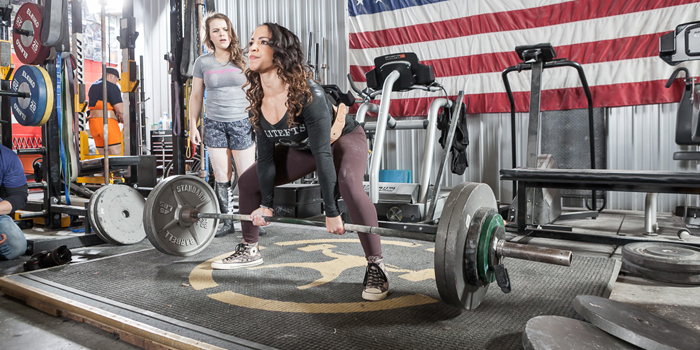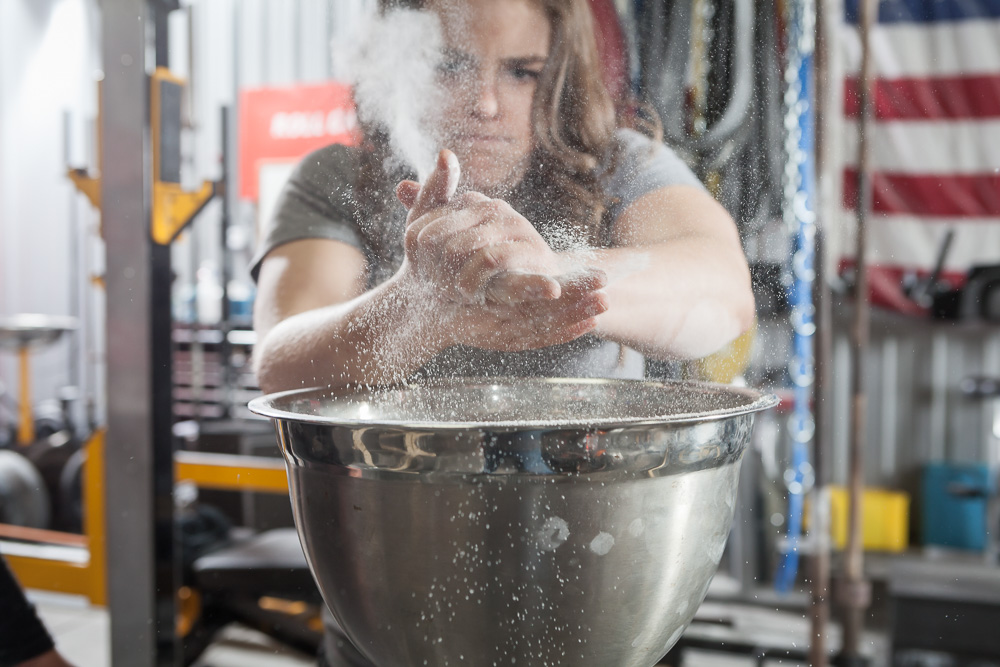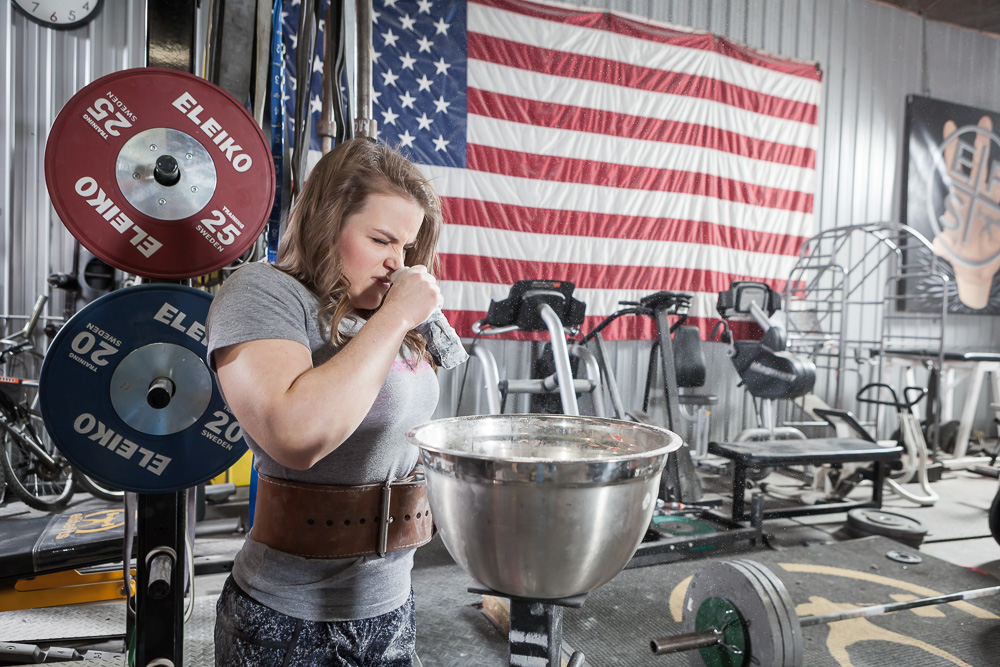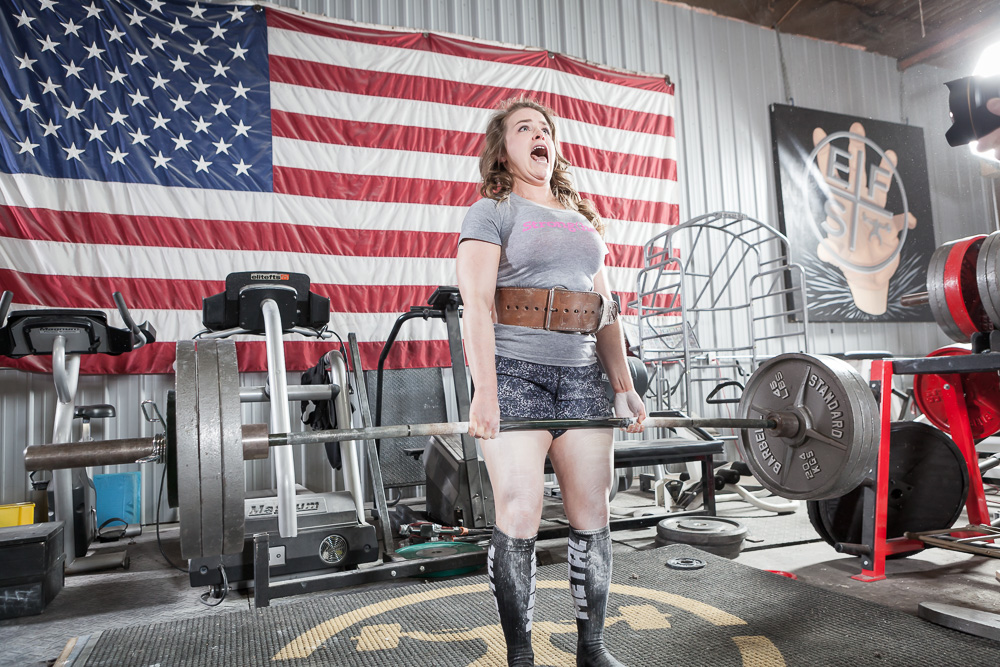
The deadlift is a movement that seems simple (just picking the bar up off the ground, right?), but is really more technical than people give it credit for. This, combined with the injury risk if done incorrectly, makes the deadlift a very intimidating movement for beginners who haven’t been taught the right way to perform it. Particularly for females new to barbell lifts, often times they can be less confident in performing the deadlift than other movements like the squat or bench press. This can be largely due to the fact that variations of the squat and bench are incorporated into the vast majority of fitness programs, group classes, and are fairly well-known movements. Deadlifting a heavy barbell off the ground, however, can be a completely new challenge for many beginners.
We found that when we surveyed the 35 college-age women in our Bobcat BarBelles Women’s Strength Training program at Ohio University, that the majority (over 75%) of them lacked confidence and knowledge in performing the barbell deadlift. After a few weeks of coaching correct technique, cueing, and encouraging the lifters, we saw their confidence levels rise dramatically. Their self-reported level of confidence and knowledge in performing the lifts increased by over 75%, and 100% of the women said they were confident enough to perform the deadlift on their own. This was the biggest change in confidence of the three lifts we covered (squat, bench press, deadlift). Providing an encouraging but challenging training environment along with teaching correct technique can make all the difference in making what was once an intimidating lift into one of their favorite to perform.
RECENT: Strong(her) Squat Progressions for the Novice Female Lifter
In the first two articles of this series we covered the squat and the bench press, and also discussed the important coaching considerations for working with a group of beginners. If you haven’t had a chance to read those articles yet, I recommend taking a look so you can understand the group coaching philosophy we used in teaching these lifts. For this final article on the deadlift, I’ll focus on the progressions, cues, and issues we addressed during our coaching sessions.
Designing a Strong(her) Deadlift
The coaching sessions for the deadlift began with a dynamic warm-up consisting of basic movements like leg swings, arm circles, lunges, and other bodyweight movements. We then used a couple additional warm-up movements to cue proper movement patterns for performing the deadlift and begin working on technique cueing before working with the barbell:
- Wall Squats: We had the lifters face the wall and work on the technique we taught them for squat (butt back, chest up, knees out). This helped warm up the hips and other muscles used for the deadlift as well as cued pushing the butt back and allowed them to practice bringing their hips all the way through at the top of the squat.
- Hip Hinge Against the Wall: We will discuss hip hinging more below, but the majority of beginners don’t understand the motor pattern of hinging the hips back. This is a good drill to practice before performing the deadlift. We had the lifters stand with their backs facing the wall (about six inches away to start), and practice pushing their butt back to touch the wall without letting their knees come forward. Teaching the lifters what it feels like to hinge their hips versus just squat down with their knees forward is extremely helpful when you begin to teach them proper deadlift setup and execution.
Just like with the squat and bench press, we began with multiple low-rep sets (one to three reps) with light weights to practice setup and technique. We used bumper plates so that we could start lighter than 135 pounds for some of the lifters, and then increased weight as we evaluated them and they became more comfortable performing the movement. We taught all of the women the conventional deadlift because time restrictions didn’t allow us to teach both conventional and sumo, and conventional is most applicable to the common beginner. We used the following instructions for setup right from the beginning:
- Begin with your feet hip-width apart, with your shoelaces directly under the barbell.
- Reach down to grab the barbell by first getting your lats and abs tight, then pushing the butt back to hinge the hips back as you lower yourself down (re-creating the hip hinge drill above).
- Grip the barbell outside the knees about shoulder width apart (we began with an overhand grip, then taught a mixed/over-under grip as the weight got heavier).
- Pull the slack out of the bar by squeezing the lats (think “protect the armpits”), getting the abs tight, and screwing the feet into the floor (external rotation).
- Execute the deadlift by bringing the chest up, squeezing the glutes as the bar reaches knee-level, and locking out back, hips, and knees all at the same time to stand upright.
- Lower the bar by pushing the butt back again and controlling the descent.
- When performing multiple reps, reset completely and begin from a standing position to practice setup and technique.
Just like with the squat and bench, these lengthier descriptions are great for initially explaining the deadlift. Once the lifters begin performing the movement, however, we utilized simple cues to reinforce technique (explaining things further in between sets as needed):
- “Everything TIGHT” (fixes many issues with all the big lifts)
- “Butt back” (reminder to hinge the hips back to grab the barbell vs squatting down with the knees over the bar)
- “Toes up” (way to cue keeping the weight in the heels during setup)
- “Slack out” (reminder to create tension to prevent jerking the bar up off the floor)
- “Eyes up” (to prevent the lifter from looking down as they begin the lift)
- “Chest up” (along with “eyes up”, encourages the lifter to bring the hips down slightly and lead with the chest when beginning the deadlift)
- “Squeeze glutes” (cue to lock out hips using glutes vs just leaning backwards)
- “Tuck your tail” (this is a goofy one but it really helps with getting a lifter to use posterior pelvic tilt for lockout, which we’ll discuss more below)
RECENT: Strong(her) Bench Press Progressions for the Novice Female Lifter
As we went through each set with the lifters, we were able to identify muscular weaknesses and motor pattern issues that kept them from deadlifting to their full potential. Some of the most common issues were:
Knees Too Far Over the Bar/Back Rounded At Setup
The Cause: This can be a flexibility issue, but in most cases it was caused by the lifter trying to squat straight down to pick up the barbell and not rotate their pelvis or hips correctly.
The Solution: We had these lifters practice hip hinging against the wall, and also evaluated their ability to pelvic tilt. We showed the difference in how much your back rounds when you bend over just by reaching downwards, versus arching the low back and pushing the hips backwards as you reach down. We also practiced this motor pattern by having the lifter lay on their back and place their hands under their low back. We then had them practice arching to pull their low back away from their hands, and then doing the opposite (posterior pelvic tilt) to press their low back against their hands. Learning the motor control for their hips allowed them to stay in a better position to set up and grab the barbell. Another cue that helped with teaching the arched back/hip hinge is a goofy one (and you have to be mindful of your audience), but it works really well. The cue of “pretend like you’re trying to show off your butt” really makes it click for some of the lifters to understand arching their back and pushing their hips backwards. If the lifter continues to struggle and we don’t feel confident in having them deadlift from the floor safely, you can have them pull off of blocks/mats to work on technique until they are able to deadlift with a flat/stable back and good hip position.
Hips and/or Knees Not Locking Out All the Way
The Cause: This is often times a case of not utilizing the glutes to lockout. Many new lifters think that they just need to lean backwards in order to lock out the deadlift. This is not only a risk for injury, but also won’t allow them to utilize some of their strongest muscles of the glutes and hamstrings.
The Solution: Working on the posterior pelvic tilt (mentioned above), and cueing the lifter to squeeze the glutes and “tuck their tail” at lockout will help them to lock the hips and knees out correctly. Using the “toes up” cue and making sure that the weight is kept in their heels will also help with not letting the knees shoot forward. The knees shifting forward can also be from rushing the lockout, so make sure to encourage the lifter to be patient as the bar comes above the knees and focus on squeezing the glutes. Bringing up strength in the glutes and hamstrings will also make a big difference in locking out correctly.
Falling Forward/Getting Stuck at Knee Level
The Cause: For many of the lifters, this was caused by the bar getting too far away from their center of gravity. We explained to them the concept of deadlifting being a teeter-totter, and if you let all the weight get too far in front of you, you’re going to get stuck.
The Solution: The cues of “toes up” and “pull through your heels” helped with keeping the weight off their toes. Many of them just needed to practice keeping the barbell against their legs as they pulled. We worked on this by having them take an empty barbell and practice hip hinging against the wall while sliding the barbell up and down their thighs. This helped them to practice the motor pattern of hip hinging while staying tight and getting comfortable with keeping the bar close to them. Once they were ready to deadlift from the floor again, we would have a coach or fellow lifter put their hand an inch or two in front of the barbell as they deadlifted, to help mentally keep them from letting the bar drift away.
This is far from a comprehensive list, but it should help with addressing common issues you may see in working with absolute beginners.
The above progressions, cues, and teaching techniques are a great foundation for teaching the beginning female lifter the deadlift. Strength will always need to be improved, and this takes time and consistency like with any lifter. There are a lot of women out there with a ton of potential for increasing their strength as well as their confidence, but it’s up to us as coaches and trainers to help them build the right foundation.













